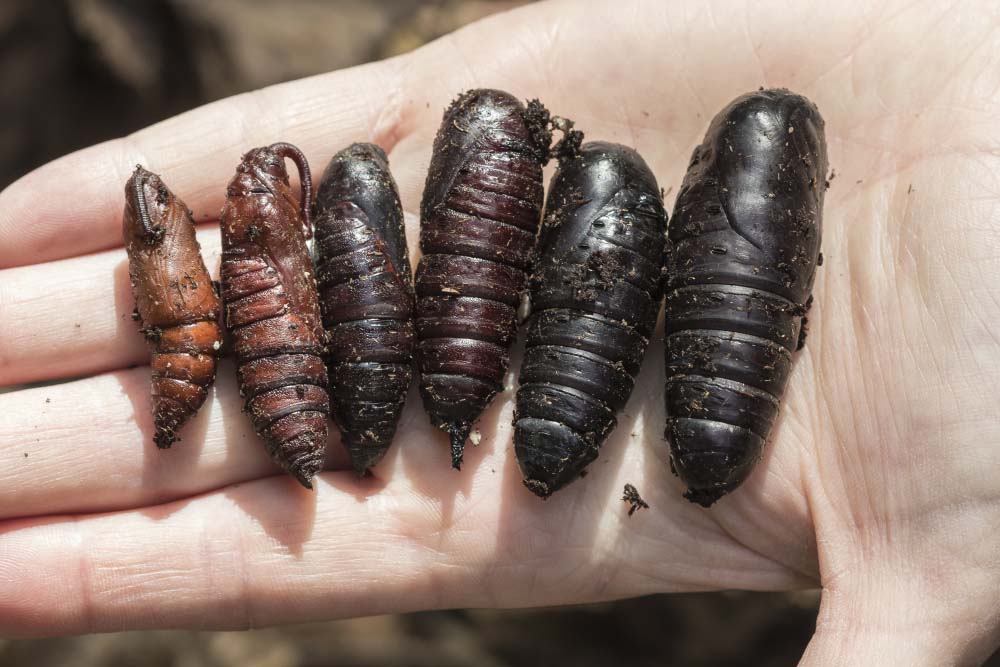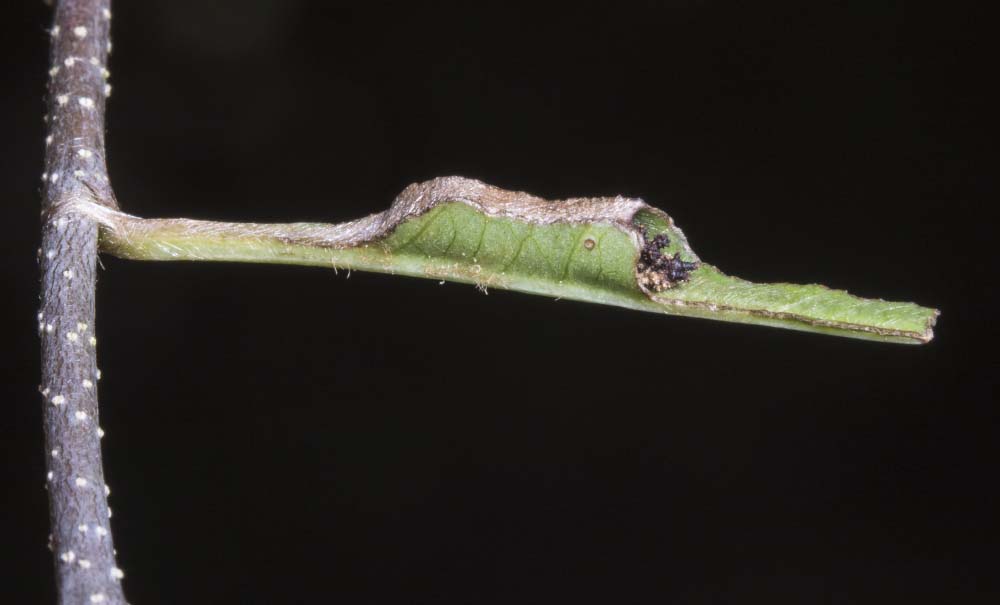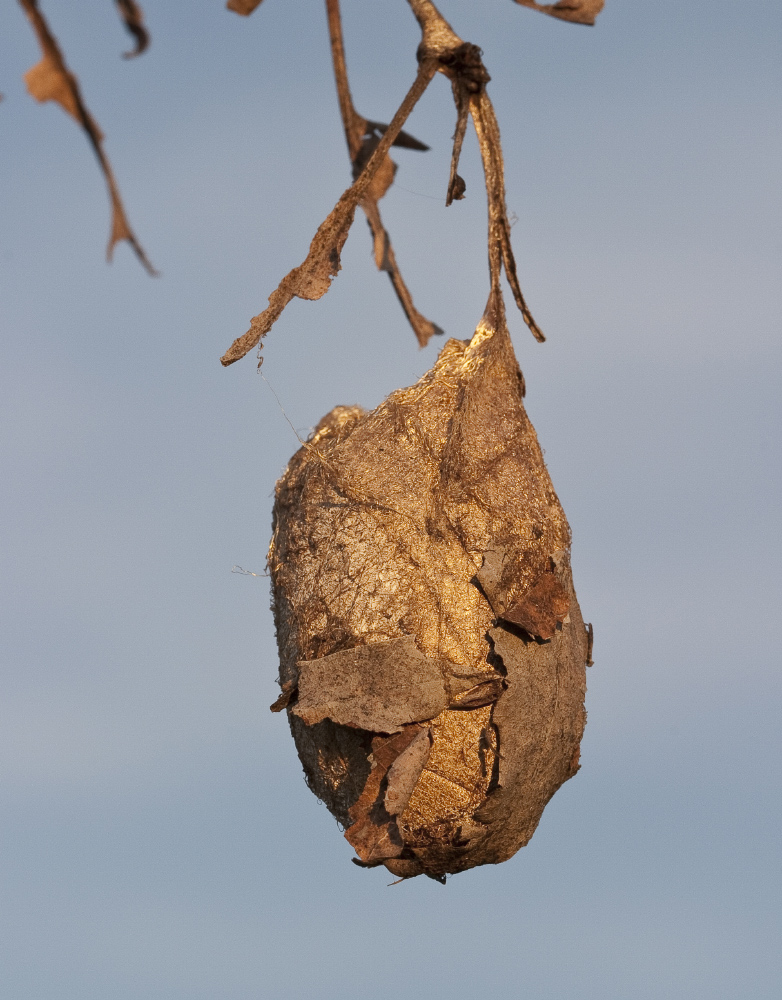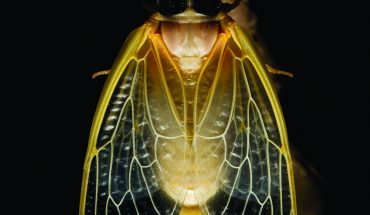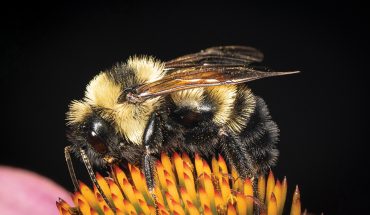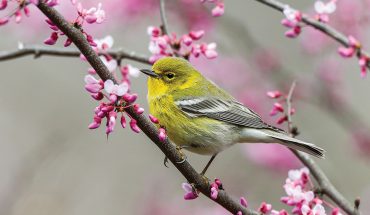It may surprise you that, here in North Carolina, caterpillars are all around us during the cooler months. Here’s how to spot them.
Words and photos by Mike Dunn
A walk in the winter woods brings crisp air, the sound of leaves underfoot, and an appreciation for the shapes and textures of so many plants hidden by leaves in the warmer months: birch bark releasing from a trunk in gentle curls, spiny grass that rises undeterred by the frost. But insects are generally absent from the landscape. Where do they go?
Look closely, and you may see clues: a rolled leaf still attached to an otherwise naked branch, an oblong tuft of fuzz under some loose bark, or maybe a brown nub attached to a dried stem with silk. As varied as these discoveries are, they’re all the work of caterpillars.
I have an inordinate fondness for caterpillars, the larval stage of butterflies and moths. A lot of people either don’t pay attention to caterpillars or want to eradicate them because they “eat my plants.” But caterpillars are one of nature’s most efficient means of converting the greenery that surrounds us into helpful pollinators and food for other animals — and they become an amazing variety of beautiful and intriguing flying adults.
Throughout my career as an environmental educator, I have used caterpillars as a gateway organism to help people understand and appreciate our local fauna, as well as the native plants that benefit wildlife. They are abundant and easy to observe and most people aren’t afraid of them. In North Carolina, there are about 177 species of butterflies, and over 2,900 species of moths, so no matter where you live, you can find a variety of these fascinating larvae throughout much of the year — even in winter.
You may recall from grade school that butterflies and moths have four distinct life stages: egg, larva, pupa, and adult. A few species of butterflies spend the winter as adults. The Monarch undergoes a spectacular migration to warmer climates, but a handful of local species, like Mourning Cloaks and Eastern Commas, stay here, seeking refuge under loose tree bark or other sheltered places. It’s always a delight to see one flitting about the woods on a sunny day in January.
A few species of butterflies and moths overwinter in the egg stage. Others spend the winter as caterpillars. Wooly Bears, the larva of the Isabella Tiger Moth, get under a rock or log for protection. The Red-Spotted Purple caterpillar makes a tiny sleeping bag, called a hibernaculum, on its host plant, Black Cherry. The larva chews away all but the base of a cherry leaf, then rolls it into a tube using silk. Look for these tiny rolled leaves on wild cherry twigs this winter — the silk keeps the hibernaculum on the twig after the leaves have fallen.
Most of our common species spend the winter as pupae. A pupa (Latin for doll) is a stationary, living, breathing phase that is the life stage where the miracle of metamorphosis occurs, as the crawling caterpillar is transformed into the winged adult. Many moth caterpillars pupate in the soil. The caterpillar buries itself in an underground chamber and sheds its skin one last time to reveal a brown cylindrical pupa that resembles a small tapered cigar butt. You may have found these while digging in your garden.
A cocoon is a type of pupa wrapped in an outer casing of silk, and often other materials, as a protective covering. Once it is wrapped up, the caterpillar molts one last time inside of this chamber to form the reddish-brown cylindrical pupa. Insects that create cocoons need to have a way to escape from it as an adult, as silk is a very strong substance. Most species do this by either cutting their way out or by secreting enzymes that soften the cocoon. Some cocoons are constructed with one-way escape holes or with lines of weakness that allow for an easier exit.
Luna Moth cocoons are wrapped in leaves and are usually found on the ground — a fuzzy-looking bundle, with a final leaf layer. Look in oak and birch trees for another species, the Polyphemus Moth. Wrapped in silk and a leaf, their cocoons are one of the easier ones to spot this time of year, as they stand out against an otherwise leafless branch and look like little brown holiday ornaments, dangling from a twig.
A chrysalis is the pupal stage of a butterfly. The word is derived from the Greek word chrysos, for gold, and refers to the metallic gold coloration found in some types of chrysalises. With so many hungry insect predators out there, most chrysalises are well camouflaged or hidden from view. Even the metallic colors on some, like the gold dots on a Monarch chrysalis or the silvery spots on that of a Variegated Fritillary, may resemble dappled sunlight through vegetation.
Swallowtail butterflies create a chrysalis that is generally attached to a vertical surface, like a plant stem. It is fastened by a silk pad at the bottom and suspended by a silk loop midway up, looking much like a telephone repairman’s safety harness. The result is a pupa that looks more like a broken twig than something a hungry bird might want to eat.
It often surprises folks to learn that so many of our butterflies and moths spend several months as a pupa, nearby but hidden from view, waiting until the right time next spring or summer to emerge and begin the cycle anew. For me, it is just another mystery that makes learning about caterpillars so compelling. It is also an important reason for the growing trend to “leave the leaves” in your flower beds, because so many insect species overwinter in leaf litter or on dry plant stems.
We don’t have to be like pupae in winter, stationary and wrapped up against the cold. Get out and enjoy the wonders of nature in this season of quiet beauty.
And as you walk in your yard or hike in a local park this winter, look closely to find one of our caterpillar friends in its seasonal guise.
_____
This article originally appeared in the January 2022 issue of WALTER Magazine

